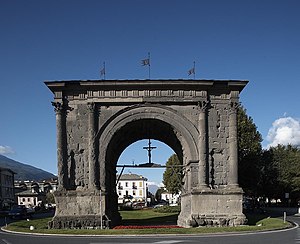Alpes Graiae et Poeninae
The Alpes Graiae et Vallis Poeninae, later known as Alpes Atrectianae et Vallis Poenina, were a small Alpine province of the Roman Empire created during the reign of Claudius (41–54 AD) after the merging of the Alpes Poeninae and the Alpes Graiae (or Alpes Atrectianae). Comprising the modern Canton of Valais (Switzerland), the Tarantaise (France), and the Val d'Aosta region (Italy), it was one of the three provinces straddling the Alps between modern France and Italy, along with Alpes Maritimae and Alpes Cottiae.
| Provincia Alpes Graiae et vallis Poenina Provincia Alpes Atrectianae et vallis Poenina | |||||||
|---|---|---|---|---|---|---|---|
| Province of the Roman Empire | |||||||
| 41/54 AD–476 | |||||||
.svg.png.webp) The Roman Empire c. 125 AD, with the province of Alpes Graiae et Poeninae highlighted | |||||||
| Capital | Forum Claudii Ceutronum (Alpes Graiae/Atrectianae) Forum Claudii Vallensium (Alpes Poeninae) | ||||||
| Historical era | Antiquity | ||||||
• Created by Claudius | 41/54 AD | ||||||
• Deposition of Romulus Augustulus | 476 | ||||||
| |||||||
| Today part of | |||||||
The province had two capitals, most likely since its creation under Claudius: Forum Claudii Ceutronum (modern Aime-la-Plagne) for the Alpes Graiae, and Forum Claudii Vallensium (modern Martigny) for the Alpes Poeninae.[1][2] The procurator of the province resided alternatively in the two chief towns. Some scholars date the unification of the two provinces to the reign of Diocletian (284–205).[1]
Name
The official name of the province was initially Alpes Graiae et vallis Poenina.[2] From the 2nd century AD to the reign of Diocletian (284–305),[3] it was known as Alpes Atrectianae et vallis Poenina, attested on an inscription from the Severian period (193–235).[4]
History
The region of Vallis Poenina, corresponding to modern Valais, between the Lake Geneva and the Great St. Bernard Pass, was inhabited by the Nantuates, Veragri, Seduni and Uberi at the time of the Roman conquest. After it was invaded by the Roman forces of Augustus in 16/15 BC, the area was initially placed under military control (praefectus Raetis, Vindolicis, vallis Poeninae) and incorporated into the large province of Raetia et Vindelicia, which stretched between the central Alps and the Danube.[5][6]
Under Claudius (41–54 AD), the Vallensian tribes were granted Latin Rights and grouped into a civitas Vallensium. Probably at the same time, Vallis Poenina was separated from Raetia et Vindelicia to be united with the newly created Alpes Graiae, forming together the province of Alpes Graiae et Poeninae, with one chief town for each division: Forum Claudii Ceutronum (modern Aime-la-Plagne) for the Alpes Graiae, and Forum Claudii Vallensium (modern Martigny) for the Alpes Poeninae.[7][5][3] The Alpes Graiae, located west of the Little St Bernard Pass and inhabited by the Ceutrones, were later known as Alpes Atrectianae from the 2nd century until the reign of Diocletian (284–205).[3]
During the reign of Diocletian, the province was integrated into the praeses of the Diocese of Gaul.[3][6] In 381, the first Bishop of the region, Theodul, was mentioned. After the Fall of the Western Roman Empire, the region was invaded by the Burgundians and incorporated into their kingdom. After its fall, it was integrated into the Frankish Kingdom in 534, then briefly invaded by the Lombards in 574.[6]
Gallery
 Amphitheater in Martigny
Amphitheater in Martigny Roman road in Martigny
Roman road in Martigny Traces of the amphitheater in Aosta
Traces of the amphitheater in Aosta Aosta theater
Aosta theater Triumphal arch in Aosta
Triumphal arch in Aosta
References
- Wiblé 1998, pp. 186–188.
- Ossenkop, Christina; Winkelmann, Otto (2018). Manuel des frontières linguistiques dans la Romania. Walter de Gruyter. p. 127. ISBN 978-3-11-039485-6.
- Graßl 2006.
- Bérard 1995, p. 348.
- Wiblé 1998, pp. 186–187.
- Frei-Stolba 2014.
- Frei-Stolba 2014: "Ebenfalls unter Claudius wurde die V. von der Provinz Raetia et Vindolicia getrennt und wohl gleichzeitig unter einem gemeinsamen Statthalter mit den Alpes Graiae (auch Alpes Atrectianae) zu den Alpes Graiae et Poeninae vereint."
Primary sources
Bibliography
- Bérard, François (1995). "Un nouveau procurateur à Aime en Tarentaise: Savoie". Gallia. 52: 343–358. ISSN 0016-4119. JSTOR 43599248.
- Frei-Stolba, Regula (2014). "Vallis Poenina". Historisches Lexikon der Schweiz. 008415/2014-01-14.
- Graßl, Herbert (2006). "Alpes Graiae". Brill’s New Pauly. doi:10.1163/1574-9347_bnp_e116380.
- Wiblé, François (1998). "Deux procurateurs du Valais et l'organisation des districts alpins". Antiquité Tardive. 6: 181–191. doi:10.1484/J.AT.2.300882. ISSN 1250-7334.
